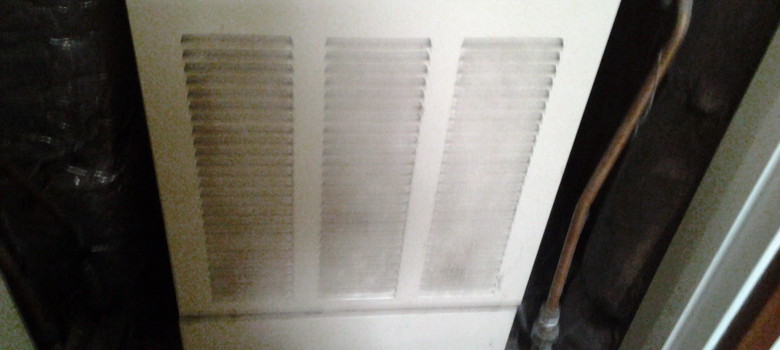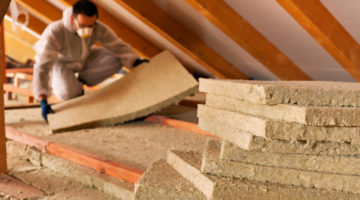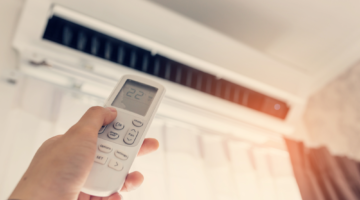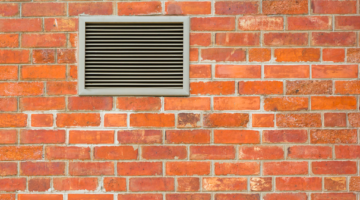
Most heating systems for homes in the UK, especially in towns, are gas fired boilers. If you have a gas supply, the obvious, and usually cheapest way to heat your home is with a gas boiler. Warm air, ducted heating is another, cost effective way to heat your home. This was a relatively popular method of heating back in the 70s and 80s, but has declined in use for domestic properties in recent years, with just a handful of manufacturers in the market.
How does warm air heating work and why choose it?
The air is pulled into the home from a vent to the outside. This air is heated over a gas fuelled flame, which is then circulated around the property via a system of ducts. This type of heating is particularly effective in well insulated properties, and in single storey properties like flats and bungalows, but can also be found in larger homes and in commercial properties.
Heating air directly with a flame is very efficient and will rival a gas boiler in terms of efficiency, whilst ducting the air around the home is also very effective, and can heat a room very quickly, as well as help prevent damp and condensation build up around the home.
 Why has warm air heating decreased in popularity?
Why has warm air heating decreased in popularity?
There are a couple of key reasons why warm air heating has diminished. Firstly, warm air cornered the market for smaller properties where boiler technology had not quite worked out an efficient way to fire a small 9kW boiler for example. Nowadays, boiler technology has solved many of these problems, and efficiency has improved markedly, making them more suitable for these types of home.
Secondly, warm air technology has not really kept up with these changes, with few of the big manufacturers showing interest in the technology, largely because the market is small, and there is little demand to retrofit ducts into an existing building.
So what are the disadvantages of ducted warm air heating?
There are some pretty significant pitfalls unfortunately, that have prevented large scale take up of the system. These include:
- Lack of water heating – Some of these air heating systems cannot heat their hot water with the same system, which means they have to choose between a separate gas boiler for hot water, or using an immersion heater. Both of these options are fairly inefficient, so any gains from the warm air system are going to be somewhat offset by the water heating issue.
- Retrofit tricky – If you have a warm air system installed as part of the initial design of the building, then great, but trying to retrofit ducts into the property is going to be really tricky, and you will probably end up with visible ducts all over the house.
- Cost and lack of installers – There are only a handful of models and installation companies on the market, so prices are not as competitive as boilers and choice is more limited.
- Moving air can aggravate allergies – As you may have seen in some of our other blogs, heating systems that move the air round the room can really aggravate allergies, because they move dust into the air very easily. Radiators do this to an extent because of the convective action of the heat they generate, but warm air systems actively move the air around the room as part of their operation, so they can be really bad news for allergy sufferers.
When is warm air heating worth it?
Warm air heating is not a bad option for some properties. Usually in a small property which is still under construction, allowing the ducting to be in-built. In a modern well insulated property which is able to in build a warm air system, there is definitely a place for this kind of heating. The problem is that there are not enough advantages over a traditional boiler to make the effort worthwhile.
Think we missed something? Do you have a different opinion?
Comment below to get your voice heard…













You state that you cannot get hot water with a warm air heating system, this is factually incorrect, I’ve got a 25+ year old system that has a waterheater incorporated in it.
I agree. I also have had a warm air system for 30+ years and have a water heater fitted. I love my warm air system and would not change it for the world.
Good afternoon
I have a warm air heating system but I’m not sure of how to operate it we have just moved into our home and feeling very cold and I also suffer with atheritis. Can you please advise
My house was built in 1975 with air ducted heating. I retired in 1999 had a new system fitted with a water heating facility. Has never been any problem. It gets serviced every year and I clean the air filters once a week. I love it. People have problems with radiators, bleeding them of air, leaking, painting them space taking, thankfully I have had none of this. Thank you Johnson and Starley
Can I ask who did you buy the new boiler from ?
I heartily agree. We have a Johnson & starlet warm air system and it is great
I understand Hot water option is available on their new boilers. No problems in 25 years cannot say more than that. Oh yes grandchildren drop Lego bits down the vent … love em
Too bad you didn’t say what system you had fitted in 1999. It would have been nice to know.
My mother’s house has a warm air central heating/hot water system installed when the house was built in 1964. The system is still going strong 50+ years on with minimal maintenance issues. and does a brilliant job of heating the (four bedroomed) house at reasonable cost. Neither she nor I can understand why the warm air system fell out of favour.
i bought a 4 bedroom bungalow which the rooms are quite large but i,m finding putting the heating on from 3pm until 9.30pm is costing around £9 per day how does that compare to your mum,s as you say hers is reasonable,.
Allergies: You stat that Warm Air Heating is bad for those with allergies. Most modern heaters now have electro-static filters that remove particulates, including pollen and cigarette smoke.
My house is of the 1960’s and already is fully ducted. My problem is my heat-exchanger which is old and is getting hard to get serviced. The system is working fine and I only want to to replace the heat exchanger.
Any advice would be appreciated.
The new generation of warm air heaters (condensing) are around 98% efficient which is more than comparable with any “wet” system. There are also water heating options and electronic filters to reduce pollutants to 1 micron. We are a service and installation company working exclusively with warm air heating. The average cost for replacement at the moment is £5300
Please can you contact me to discus options for my property?
I am looking to replace the ducting on my warm air heating system. I’m looking for an all in one ducting and insulation system any suggestions where I can purchase this?
Where are you based? I have searched for warm air solutions and have not found anything. My mother has an existing floor ducted warm air heating system but the fan unit has died and heeds replacing.
Hi, I have just bought a bungalow with a warm air heating system. Could this be updated using the same ducting, and at what cost? Thanks.
Replacing parts and/or whole heaters is easy enough, and will always be cheaper than changing to boilers and rads system. Why do people always think wet systems are better than warm air?! The only Disadvantage to warm air systems is that when the system is active, it serves heat to all areas equally, and you cant have thermostatic control on each room outlet. However, you don’t have unsightly rads on walls, fouling up your furniture layout, no scaling upon pipe work, no risk of flooding/water leakage risks, no wasted heat throughout in insulated pipes in floor voids. Warm air systems can also be run on fan only in summer to help with ventilation and cooling. Some can even be adapted for air conditioning.
Regarding no local room control, can adjustable vents not solve the issue ?
Yes, I can close a downstairs vent to ensure more warm air goes upstairs, but I don’t like the bedrooms too warm so I don’t mess around with them too much, only if someone stays over and they want more heat in their bedroom.
But they are noisy unfortunately.
My warm air unit isn’t noisy at all.
I have recently purchased a house (built around l974) with an old Lennox warm air heating system. The system has stopped working due to the bearings on the fan having failed, Does anyone know where I can purchase new bearings or of a company who does warm air system installations? Any suggestions would be very appreciated.
I had the fan in my Johnson and Starley system refurbished by Beatson fans and motors ltd, based in sheffield. Removed snd refitted it myself. Hope this is helpful
Don’t know when your question was asked but there is a place in Ipswich (Air Cool Services) who may be able to help with the bearings you seek. I, too, have Lennox war air heating system and it has been great for over 30 years now. Will soon be looking for an upgrade. Good luck.
Have you decided which kind of system you’ll be replacing it with? I’m looking to get mind changed and I’m having trouble finding the right company :/
I moved here from Canada 10 yrs ago. My home in Canada has a Lennox furnace (what we call a warm air heat exchanger). About 20 yrs ago, everyone was pitching changing the furnace to the new “high efficiency” furnaces available, a gain of about 5-7%. I’m an Electrical Engineer, what I do is efficiency upgrades to factories, power plants and the like, so pretty familiar with efficiency vs costs. So, doing the numbers, I decided against upgrading my Lennox (great brand, runs forever). Since that time, my friends who did the “upgrade” have replaced their furnaces two times at a cost of approx $10K a pop. So, regardless how much more efficient a system “claims” to be, it can’t save me $20k over 20 yrs, or $1k/yr. Suggest searching some Canadian/US web sites to get replacement bearings for the Lennox fan, it will last for yrs to come. The new fans, tho quieter and more efficient, are mass produced junk and will not last. It’s the motors that fail, the fan impeller is only the component that moves the air. If it’s noisy, replace the fan with a newer design, will give you a lower dB level. Don’t get rid of the motor, those bad boys were built when quality was more than just a marketing spin. Mine was built in 1972 and is still running today, and in Canada, the fans run significantly more often. My 2 cents worth.
Right on the money. I too, have a Lennox Warm Air system from the 1980s and is still going strong. But where can one buy a new one in the UK anymore. Any positive replies would be appreciated.
Johnson and Starley have a website, I bought my second one in 2015. The first was in our new build home in 1974 and lasted until 2015 when I decided to get an up to date model.
Johnson and Starley are based in the UK and I had a brand new Warm Air Unit fitted 5 years ago and have it serviced every year by a gas company that was recommended to me by Johnson and Starley. Our sons both have radiator heating systems and they much prefer my heating as they are sick of theirs breaking down. British Gas don’t touch Warm Air and I was told by a gas engineer when I rang British Gas that they don’t touch Warm Air heating because they can’t make any money out of it as they never break down.
We have a warm system & I love it British gas service ours every year on their home serve policy
Also I have allergies & our warm air system never affects them where as GCH exacerbates them.
British Gas service my warm air system every year
How difficult or costly is it to remove a warm air system ?
I have had warm air heating for over thirty years and I’m very happy with it. However I now need a new boiler fitting and I am struggling to find a fitter to install it. There appears to be just one manufacturer in the UK (Johnson and Starley) and they put the customer in contact with the installer in local area. I have repeatedly requested contact and so far have failed to get a response. I’m very disappointed and I would like to find another supplier who may be more interested in the business. Can you help please?
Nordec are the company British Gas use based in the south east . I contacted them directly and their quote was very expensive at over minimum of £6000 (pre site visit) The boiler is approx ( depending on model you choose ) £2500 remaining cost fitting + vat That’s a very pricey fitting cost at about £2300 1 day min to fit makes that about £300 an hour labour max . I’ll be getting quotes for conventional gas boiler to rads .
Boiler £2500
Vat £1200
Fit £2300
We bought 3 bed house about 4 years ago, which was build around 1970 and Johnson Starley Hi-Spec M31 was fitted in the house. I never seen this type of heating in any houses since I moved to UK and to be honest I was a bit skeptic. But I think it is brilliant! No damp at all, air is circulating all over the house, it is quiet and heats up very quickly. However I have 2 issues with it:
1. It was very difficult to find someone how will do the service for the domestic system, most of them do only big enterprise systems.
2. I don’t have ducting in one of the bedrooms.
However I don’t have plans to replace it, because I still think it is more efficient than the water system, it is brilliant.
I agree, the small bedroom and the bathroom did not having duct air heating but I solved that by putting a low wattage heater on the wall in the bedroom and a towel warmer in the bathroom. My energy bills are never more than £100 per month total for both gas and electric.
What woukd the cost be to remove existing hot air system to gas central heating?
I have a Husqvarna warm air heating system and have been told this make became obsolete 10 years ago so probably can’t get any spare parts if it goes wrong. Can you recommend another make to replace the Husqvarna as thinking of changing it.
What is the purpose of all these questions if there are no replies or solutions?
Doesn’t seem to stop people trying does it?
Where can I buy a replacement warm air heating furnace in the UK to replace my Lennox Warm Air central heating furnace?
Johnson And Starley Northampton
I have a Johnson and Starley boiler for warm air heating, however I find it very noisy in the room where the boiler is. The boiler is 35 years old so will probably need replacing shortly. Are the new ones quieter?
Yes they are much quieter
Excellent article. Detailed and ideas were well organized about the difference between Warm Air Ducted Heating and Wet Central Heating. I’ve got all the info I needed on this single page. Thanks.
A well-informative article about air conditioning, thanks for sharing this one.
Why not drive hot air from heat pumps through existing conventional radiator system
We have had hot air for 26 years from a 50 year old unit which is still going strong. Minimal servicing and repair costs. Show me a water system that can match that? Our hot air system has a dust filter in it so it actually removes dust show me a radiator system that has that?
Instant hot air, no water leaks, no scale problems, no bleeding rads, no painting rads. no condensation drain freezing up. basically maintenance free. 3 bed town house.
Good afternoon I have s warm air heating in my property but I don’t know how to use it. Is it possible to have an engineer to come and have a look at it and show me how to use it
I used to install these systems in the 70/80s and the biggest down side to them was when you came in to a cold house you switch the system on and get blasted by a gale force blast of cold air before it warmed up and the fan unit could be very noisy
My house was built in 1980 with warm air central heating. It’s now 40 years old and still doing the job. It’s a Balmforth BD50 model, in our case it has no hot water heater but I understand these were an option. I do smile to myself when wet system evangelists tell me my system is inferior to their system – I know they are wrong in so many ways. It’s always fun to point out that when their system springs a leak they end up with water making a right mess, whereas if my system leaked I would end up with hot air all over the ceiling…. 8). It’s such a shame that the building industry turned it’s back on these systems just to save a few quid, I’m not looking forward to ever having a home with a wet system. I also note that your explanation at the top of this page is somewhat in error, the air inside the house is recirculated, it is mainly the combustion air that is drawn in from outside.
It might be a silly thing to ask but how do you dry clothes at hime without radiator lss? Im assuming its regular trips to the laundrettes?
Of course not, I bought a pop up clothes airer and hang my light clothes and towels on that near the vent, it is dry in two hourse. With regards to bedding, I wait for a good day and hang them out and then air them off on the clothes airer.
Washing line, clothes airer?
You put the clothes on an airier in front of the vent and it dries a full load in a few hours. No launderette needed. I used to dry my hair in front of my vent when I was a child so no need for a hair dryer either.
Does air duct heating have the advantage of being suitable for air conditioning (cooling) in the summer of a reverse cycle unit is fitted?
Good morning I am writing because I have a warm air heating system in a bungalow first installed when bungalow was built (the 1970s). Ducting is all there etc. There is no gas on site. I am trying to source a supplier for a new electric warm air heating unit to replace the old out date one I already have. Please can you help. Kindest Regards Kevin Cross
Hi Kevin
I am in the same situation for my Mothers house. Her bungalow has a serviced & working oil fired boiler with a separate warm air fan unit at the opposite end of the bungalow. There is an underfloor pipe that transfers heat from the boiler to the fan unit which blows air through ducts in the floor throughout the bungalow. Sadly the fan unit has died, and I can’t find anyone who replaces it or even could repair it. Did you have any luck finding help on your system?
Central air conditioning and heating is a MUCH NEWER and EFFICIENT method of heating and or cooling a home, safer too. It is crazy to have the best spaces in a house for furniture unavailable because of radiator placement and the radiators are ugly! My great-grandmother lived in an old 1880’s building with radiators. They got hot. They are flat dangerous for a child.
On another subject, why don’t English residential bathrooms have cabinets under the sink in the bathrooms? Every house that is actually lived in has a grooming/cleaning products just laying here, there and yonder. It looks so trashy and low class. Your rich live in homes with cabinets under their bathroom sinks. There homes are appear neat and organized. If space os a problem, Ikea sells small bathroom sinks with cabinets. The only pedestal sinks should be in half baths if even there. It looks so sloppy to have toothpaste, mouthwash, shaving cream, etc.,and other items in plain sight.
We have a starling & Johnson warm air system – when we got s new system in they put a fairly large hole in the outside wall of our living room (for ventilation?). We have had to stuff it up with bits and pieces as in the winter we get a howling gale which defeats the object of having the heating on. Any suggestions?
It sounds like the hole in the outside wall is to ensure an air supply to the burners. If the air supply to the burners is not adequate there is a possibility of the burners producing carbon monoxide. So for safety’s sake unblock the hole immediately! And then buy a carbon monoxide monitor and fit it near the heater.
You could consider taking the air supply from eg the loft if you house layout allows. But then the loft must have an adequate air flow from the outside.
I am trying to reply to Marie about her hole in the living room wall. It sounds like it it there to ensure an adequate air supply to the burners. If the air supply is inadequate there is a possibility of the burners producing carbon monoxide. So for safety’s sake unblock the hole immediately!
If the house layout permits, then consider taking the air supply from eg a loft outside of the inhabited part of the house. But then the loft should also have an air supply from the outside.
I was told that if there is a carbon monoxide fear the heating system cuts out. I also bought a carbon monoxide unit for the wall in the room.
You have missed out the hostile attack by wet system manufacturers starting in the ’80s on warm air or any other more logical methods. IE where is the logic in heating water to subsequently give up that heat to air via large cumbersome metal things? No other developed country with a similar or more severe climate to the UK concentrate on wet systems. Most Canadians visiting the UK think our heating systems (“radiators”) are plain loony.
Does ducted warm air heating become more interesting when energy source is from ground or air source heat pumps which only produce low temperature as an alternative to underfloor heating. We already have a whole house ventilation system which filters incoming air so presumably it could be arranged for this unit to accept warmed air in the Winter.
I HAVE A LARGE 5 BED OPEN PLAN HOUSE WITH WARM AIR .WE LIKE THE SYSTEM COST HIGH BUT OK. JUST HAD A SPLIT AIR CON FITTED TO THE LAST TWO BEDS ON THE LINE SO BLOCKED OFF THE AIR RUN TO THEM IN LOFT INPROVING THE AIR FLOW TO THE REST OF UP STAIRS.THE COST OF HEATING FROM THE SPLIT SYSTEM IS QUITE GOOD PLUS ITS MUTCH MORE CONTROL ABLE.WE WERE THINKING CAN I RUN THE A LARGE AIR CON UNIT IN EXISTING UP STAIRS DUCTING AND BLOCKING IT OFF TO GROUND FLOOR
my johnson and starley warm air system is 48 years old and still works perfectly most important to use modern filters . have an instant fire gas heater for the water tel me what happens when your combi packs up !
We have the old warm air heating, which you have no control over the heat in separate rooms. Do we need a carbon monoxide monitor?
Interesting article but things are changing fast with gas and energy prices going through the roof and restrictions on future gas supply make this article a bit outdated
We now have to think outside the box ie extracting captured solar heat etc glass house/poly tunnel principle as one example.
There is an old warm air ducting system in my house which has been replaced with a gas central heating system. The ducts to the outside are still open, is it ok to block there up as the floor gets incredibly cold and what would you recommend using to block up the vents? Thanks Sue
I wonder if you would be able to give me an approximate cost to replace the gas fired heating system to a three bedroom detached house with existing ducting?
Also, there is a hot water tank just by the heating unit, and appears to be plumbed in as no immersion heater is present.
This is a house we are considering buying.